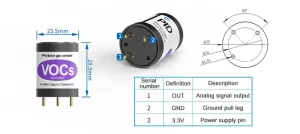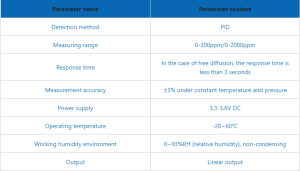Air pollution is a global issue that affects millions of people, leading to adverse health effects and decreased quality of life. With the increasing concern about air quality, wearable gas sensors have emerged as a promising technology for personalized air quality monitoring. This article explores the applications and benefits of wearable gas sensors in providing individuals with real-time, personalized information about the air they breathe.
Real-Time Air Quality Monitoring:
Wearable gas sensors enable individuals to monitor air quality in real-time, empowering them to make informed decisions about their activities and exposure to pollutants. These sensors can detect various gases and pollutants, including volatile organic compounds (VOCs), carbon monoxide, nitrogen dioxide, and particulate matter. By wearing a device equipped with gas sensors, users can continuously monitor their immediate environment and receive instant feedback on the air quality around them. This real-time data allows individuals to adjust their activities or change their location to minimize exposure to harmful pollutants.
Personalized Health Monitoring:
One significant advantage of wearable gas sensors is the ability to personalize air quality monitoring. Different individuals may have varying sensitivities to different pollutants. With wearable gas sensors, users can track specific pollutants that are most relevant to their health concerns. For example, asthma sufferers can monitor VOC levels, as these compounds can trigger respiratory symptoms. Similarly, individuals with cardiovascular conditions can focus on monitoring pollutants like nitrogen dioxide, which can impact heart health. By personalizing air quality monitoring, wearable gas sensors aid in maintaining better health outcomes for individuals with specific health conditions.
Environmental Awareness and Behavior Change:
Wearable gas sensors not only provide individuals with personal air quality information but also contribute to environmental awareness and behavior change. When individuals see real-time data on pollutant levels, there is a greater appreciation for the impact of their daily actions on air quality. This awareness can lead to behavior changes such as choosing alternative transportation methods, avoiding heavily polluted areas, or supporting initiatives for cleaner air. By promoting individual responsibility and engagement, wearable gas sensors help create a collective effort towards reducing air pollution and improving overall environmental health.
Integration with Health Tracking Platforms:
Wearable gas sensors can be integrated with health tracking platforms and mobile applications, providing comprehensive health insights to users. By combining air quality data with other health metrics like heart rate, sleep patterns, or physical activity levels, individuals can gain a better understanding of the correlations between air quality and their overall well-being. This integration allows for a holistic approach to health management, enabling users to make connections between their environment and their health outcomes.
Citizen Science and Data Sharing:
Wearable gas sensors also contribute to citizen science initiatives and data sharing. Users can participate in crowd-sourced air quality monitoring by sharing their sensor data with research institutions, environmental organizations, or government agencies. This collective data helps create a more comprehensive picture of air quality at various locations, facilitating targeted pollution reduction efforts and policy-making. By actively participating in citizen science initiatives, individuals become advocates for clean air and actively contribute to a healthier and sustainable environment.
Conclusion:
Wearable gas sensors offer personalized air quality monitoring, allowing individuals to make informed decisions about their daily activities and exposure to pollutants. Through real-time monitoring, personalized health tracking, behavior change, integration with health tracking platforms, and citizen science participation, wearable gas sensors empower individuals to take control of their health and contribute to improving air quality on a broader scale. As this technology continues to evolve, it holds great potential in addressing the global challenge of air pollution and creating healthier living environments.
 : +86 155 8830 2704
: +86 155 8830 2704 : jxdziot@gmail.com
: jxdziot@gmail.com
